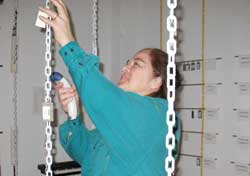Playing with the meaning of music

Rosemary Mountain adjusts some of the coded tags in the Interactive Playroom on display at Oboro Gallery.
Photo by Barbara Black
Rosemary Mountain’s Interactive Playroom is generating interest from many quarters, because psychologists, artists and musicologists could all exploit it in some way.
While she chose to call it a “playroom” to emphasize its fun side, it has a serious dimension. Mountain, a composer-musicologist, is exploring the perceptual and cognitive issues of music consumption, looking for appropriate ways to analyze the growing diversity of musical styles.
It’s an intriguingly simple concept: a three-dimensional grid of white plastic chains hanging from the ceiling. The three axes of the grid are identified by opposites, some obvious, such as loud/soft, others less so, such as spicy/bland, or even sincere/insincere.
The participant picks up a little wooden chip with a bar code on it (in fact, it could be any small object), and passes a hand-held scanner over the code. That action activates a 10-second musical phrase. The idea is to attach the chip to the grid where the listener thinks it belongs.
For example, when I tried it at her current show at the Oboro Gallery, the axes were strong/ weak, clean/dirty and serious/ playful. The music was a snatch of orchestral music; it sounded like a bit of Vivaldi’s Four Seasons. I thought it was pretty strong, very clean and moderately serious.
Playing in the Playroom forces the listener to make decisions about how the music sounds to them. Several people making such decisions about the same piece of music might agree or disagree, but at least they would have a vocabulary to talk about it. For example, a dancer or filmmaker collaborating with a musician could develop a glossary of adjectives that would help them create a new work.
“The Playroom is unique in a few ways,” Mountain said. “Generally, its ease of use, playfulness, and lack of prescribed means of use encourages many people to explore. We are likely to be able to get a much fuller impression of how diverse groups of people think about sound and sound-image-movement interactions than most research conducted among peers of a single discipline.”
Mountain has been talking to a psychologist who wants to use it for multidimensional scaling, in which people are asked to rate the degree of similarity between pairs of objects. Normally, the computer takes the results of these tests and plots them on a three-dimensional diagram; the Playroom could make that 3D diagram concrete.
“Other psychologists have spoken to me about importing their data from other studies conducted in typical laboratory surroundings to see whether we get the same results from the Playroom.”
A video screen can be used to determine how visual images affect reactions to sound. The use of a SMART Board, donated by the manufacturer, encourages people to give a non-verbal expression of a sound they hear through a drawing.
Mountain wants to add other elements, such as a modulator “somewhat like an exercise bicycle, whereby a person can alter aspects of the sound, such as speed or register, or image, such as colour filters, through physical movements.”
She has been talking to Concordia digital fibres expert Barbara Layne about fabric swatches with embedded technology that would be another way to pair images with sounds. She’s even exploring the idea of a virtual version of the Playroom, perhaps even a full VR (virtual reality) one.
Mountain helped build Hexagram, the inter-university Institute of Research/Creation in Media Arts & Technology, and was its scientific director from 2004 to 2006. It was a major funder of the project.
Harry Mountain, her husband of 32 years, is trained as a sculptor. He is responsible for the idea of the plastic chains and the integration of the barcode technology. “He has tremendous breadth of expertise, and is always willing to listen and ask probing questions.”
Graduate students also have been invaluable, including doctoral candidates Osama El Demerdash (Computer Science), Randolph Jordan (Humanities, Film & Sound) and André Arnold (SIP, Design), among others. Research assistants are on hand to guide visitors through the show at the Oboro Gallery, 4001 Berri St., until May 12.